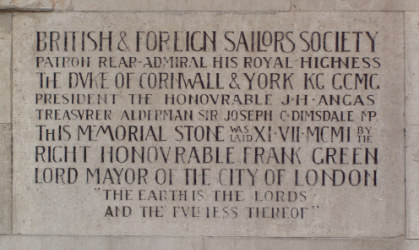Sailors from all over the world came to Docklands. Many needed a place to stay while they waited for their ships to be loaded and a number of seamen’s hostels were founded, often by missionary societies, to provide cheap, short-term accommodation.
George Sims, 1900
The Sailors Palace was known for the quality of the accommodation provided.

History
The British and Foreign Sailors Society was formed to assist merchant sailors whilst in London. The Society first opened a hostel in an old war sloop on the Thames in 1818 and then opened a sailor’s institute in Shadwell in 1856. By the turn of the century the Society was working in more than a hundred ports across the world. But with the lease of the headquarters at Shadwell about to expire and The expansion of the London Docks and the expiration of the Shadwell lease caused the Society to look for a new home.
Edwards was attracted by the Society’s temperance principles and because he saw the proposals, a home where sailors of all nationalities would find shelter, as creating an international peace centre. He offered to build a building for their new headquarters, estimated at £5,000. As the proposals developed the costs, and Edwards’ contribution, increased. He eventually gave £14,000, the greatest amount ever received by the Society from one person. Edwards said that although he had cooperated with many others, and in many ways, to improve the conditions of life, nothing had given him more satisfaction than his active connection with the Society.
The architects Niven and Wigglesworth were chosen to design the building, fronting on to the East India Dock Road, Limehouse, close to the docks and similar homes for foreign sailors, and the foundation stone was laid in 1901. By the time the ‘Sailor’s Palace’ was opened by the Prince of Wales, in May 1903, the cost had risen to £18,000 but the total costs were more than £30,000, contributions arriving from Heads of State, associations, and individuals, across the world.
The building is predominately of brick, with bands of Portland stone and arched windows at ground-floor level. The main entrance and turreted gatehouse, described as a very free Tudor adaptation, is the dominant feature of the building with a magnificent figurehead of Britannia, carved in Portland Stone above the doorway, holding a ship in each hand, behind which a cherub blowing wind into its sails. Around the arch of the door, below the figurehead, are names of the continents: AMERICA AFRICA OCEANIA AUSTRALIA ASIA EUROPE, whilst above her head are the names of the 4 winds, EURUS – NOTUS – BOREAS – ZEPHYRUS.
Above Britannia is a lead plaque inscribed with the “Passmore Edwards Sailors Palace” and “British & Foreign Sailors Association”.
The ornamental plaques are continued around the building in keeping with the Arts & Craft Movement.

On the ground floor were the Albert Victor Sailors’ Rest, and accommodation for the ordinary sailors, the American Room, a temperance restaurant and the smoking room whilst the first floor accommodated the Society’s offices and Boardroom, and the Passmore Edwards Ocean Library. On the second floor was the officers’ and apprentices’ flat and on the top floor, an observatory, navigation room and staff accommodation.
The addition of the Alexandra Wing, named after the Queen, almost doubled the size of the original proposal and contained a hall, Captain’s and officer’s dining room, a tearoom and the King Edward VII Nautical School.

The nautical school was for the training of officers for the Merchant Navy. In 1926 the school was recognised by the London County Council as a Technical School and in 1949 the LCC implemented a scheme by which senior courses were established at Sir John Cass College, while junior courses remained at the King Edward VII School. During the 1960s the Department of Navigation at Sir John Cass College merged with the King Edward VII Nautical College and moved from East Indian Dock Road to a new building at Tower Hill, London. At the same time Jack’s palace was closed and the building sold to the Toynbee Housing Association, today providing much needed social housing.
Since 1995 the Society has been known as the British and International Sailors’ Society, and still works for the ‘material, moral and spiritual welfare of seafarers in ports throughout the world’.
Edwards was amused that the hostel became to be known as Jack’s Palace. He had been known as Jack when a lad and had now provided a home for sailors away from home.

